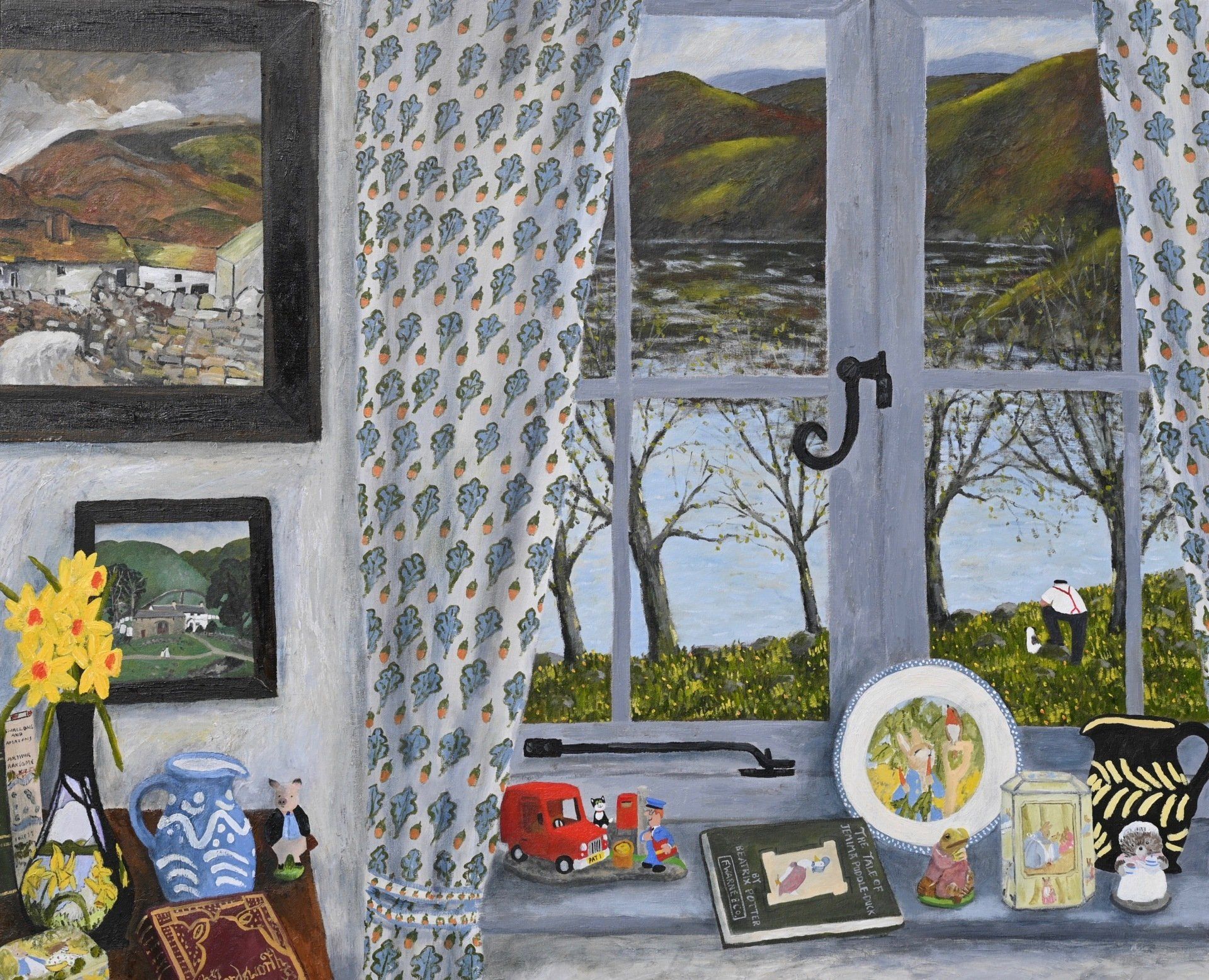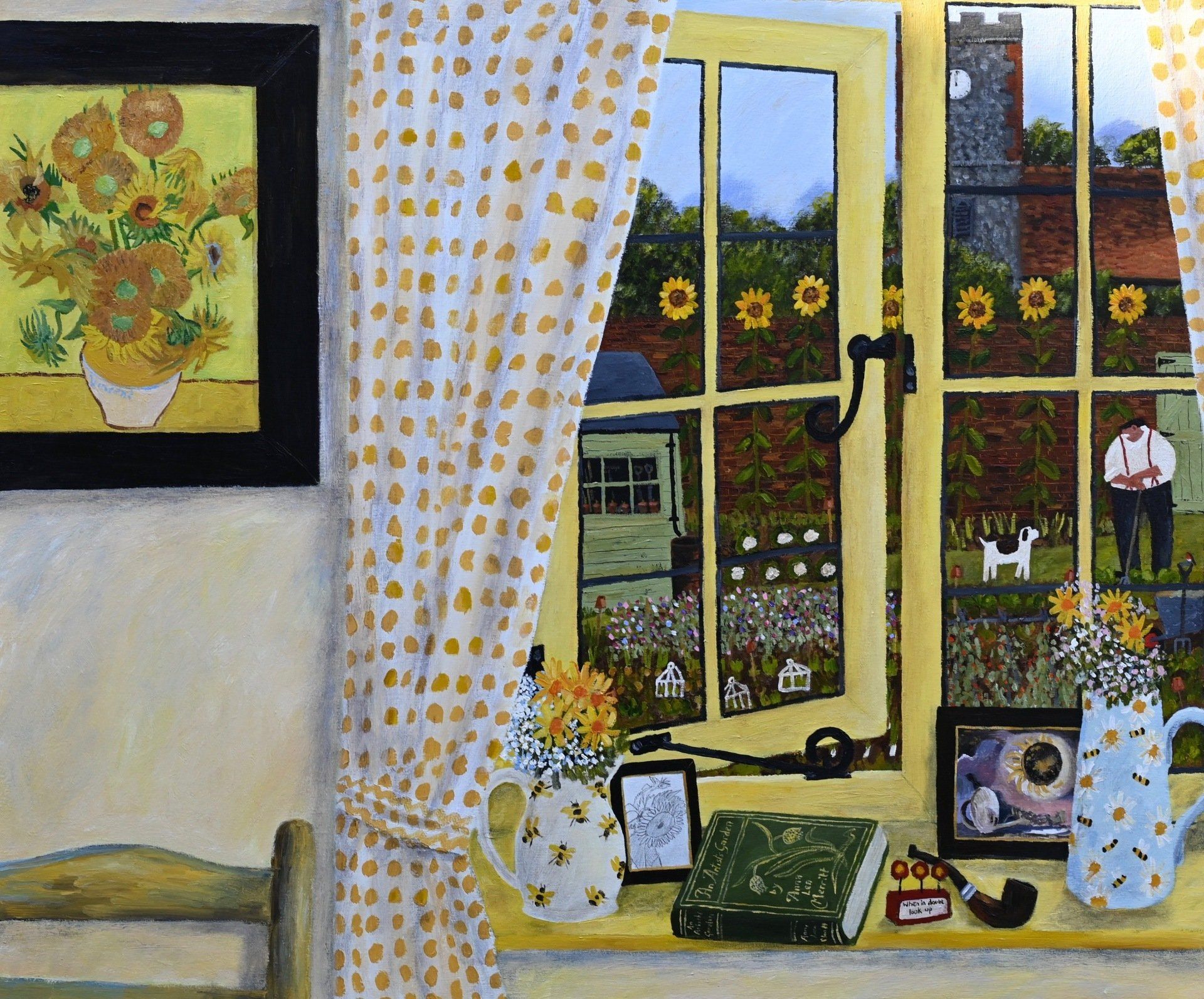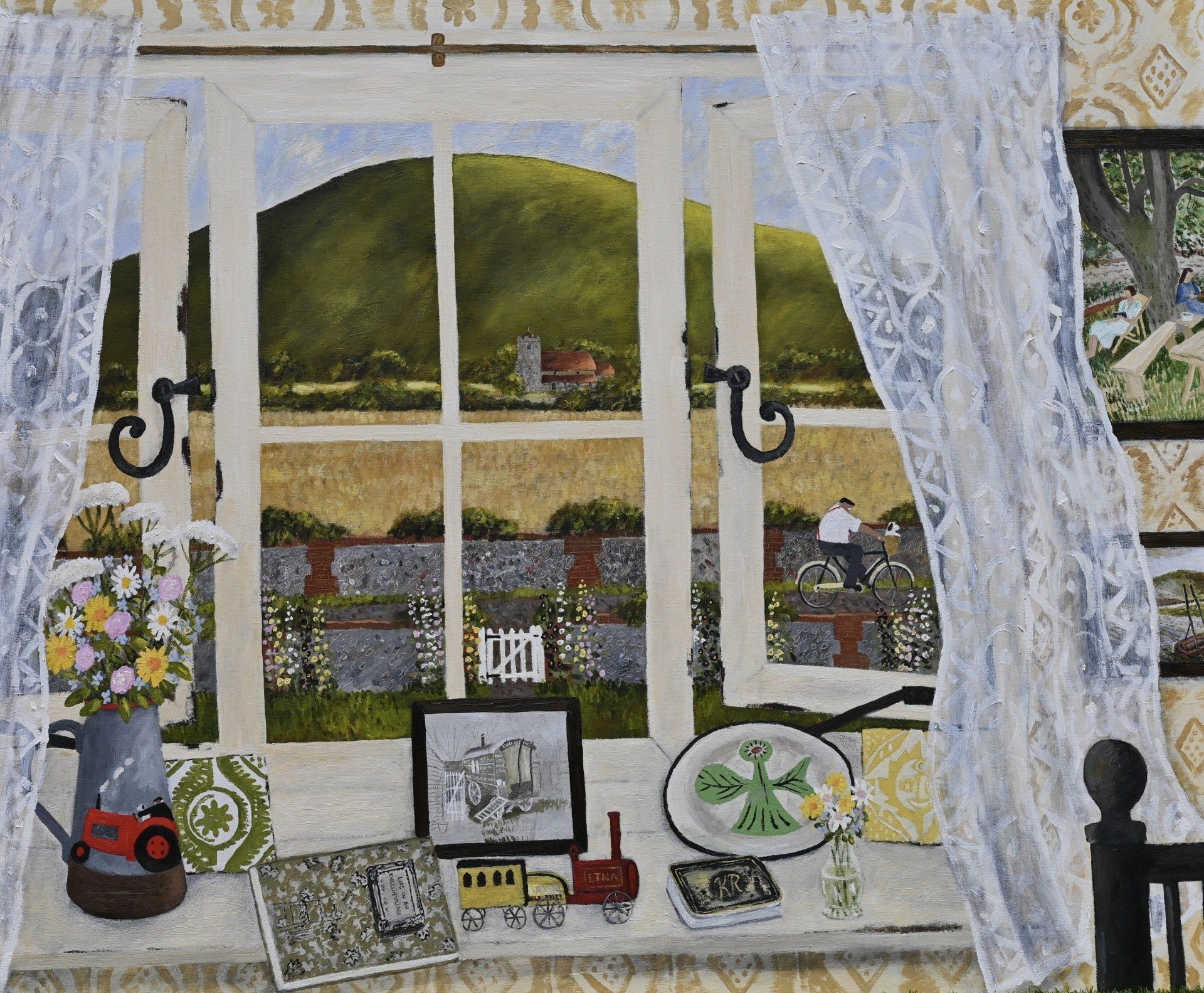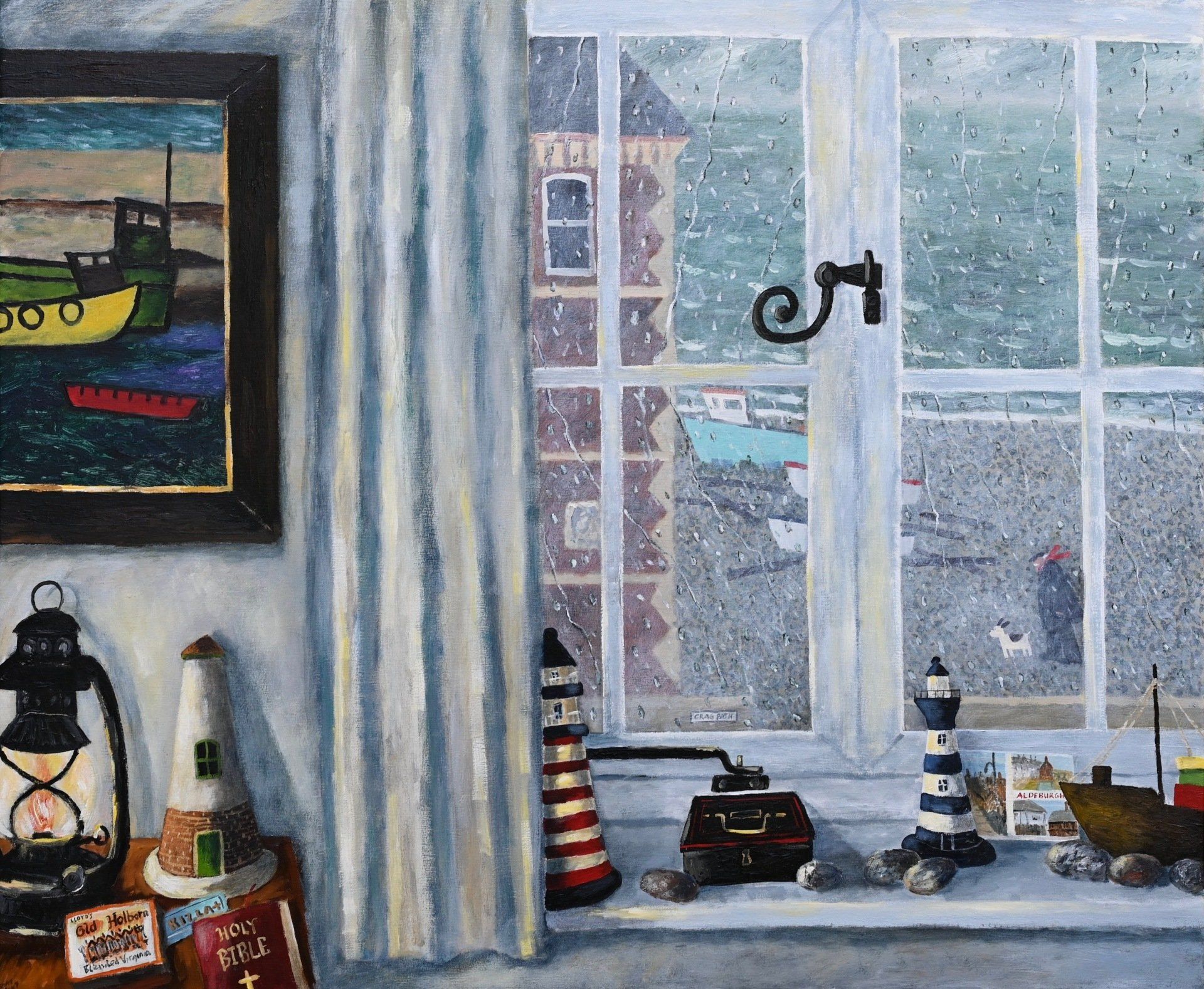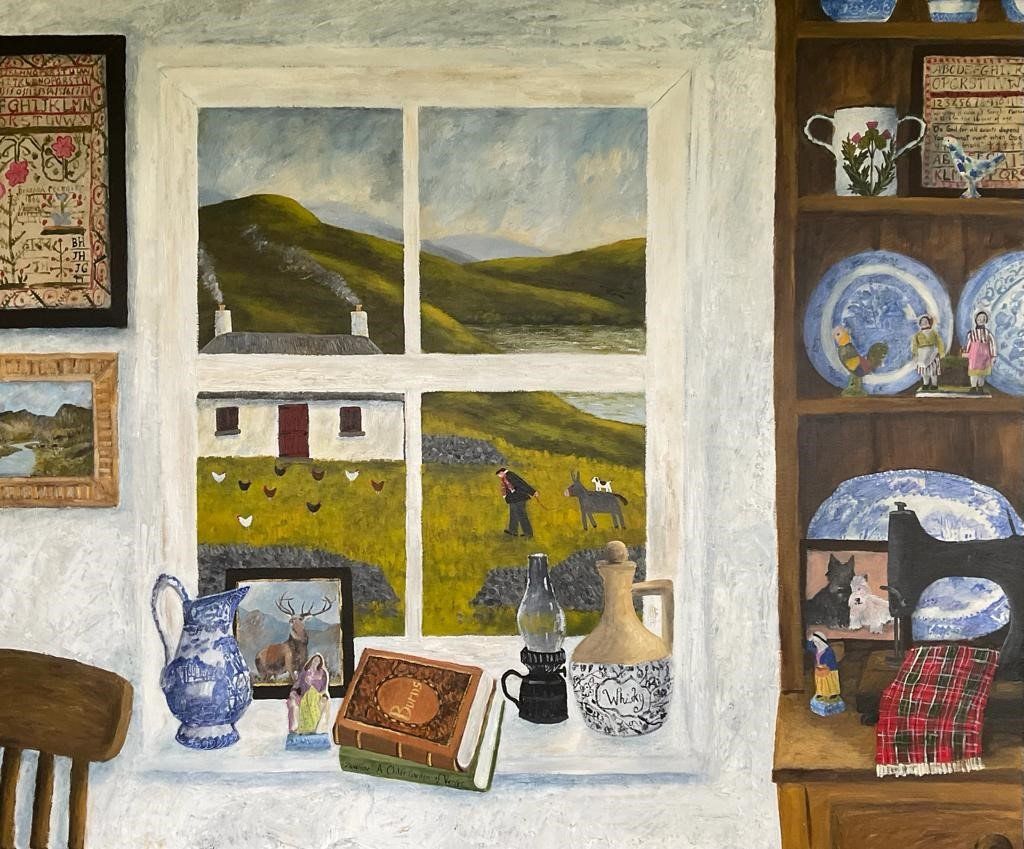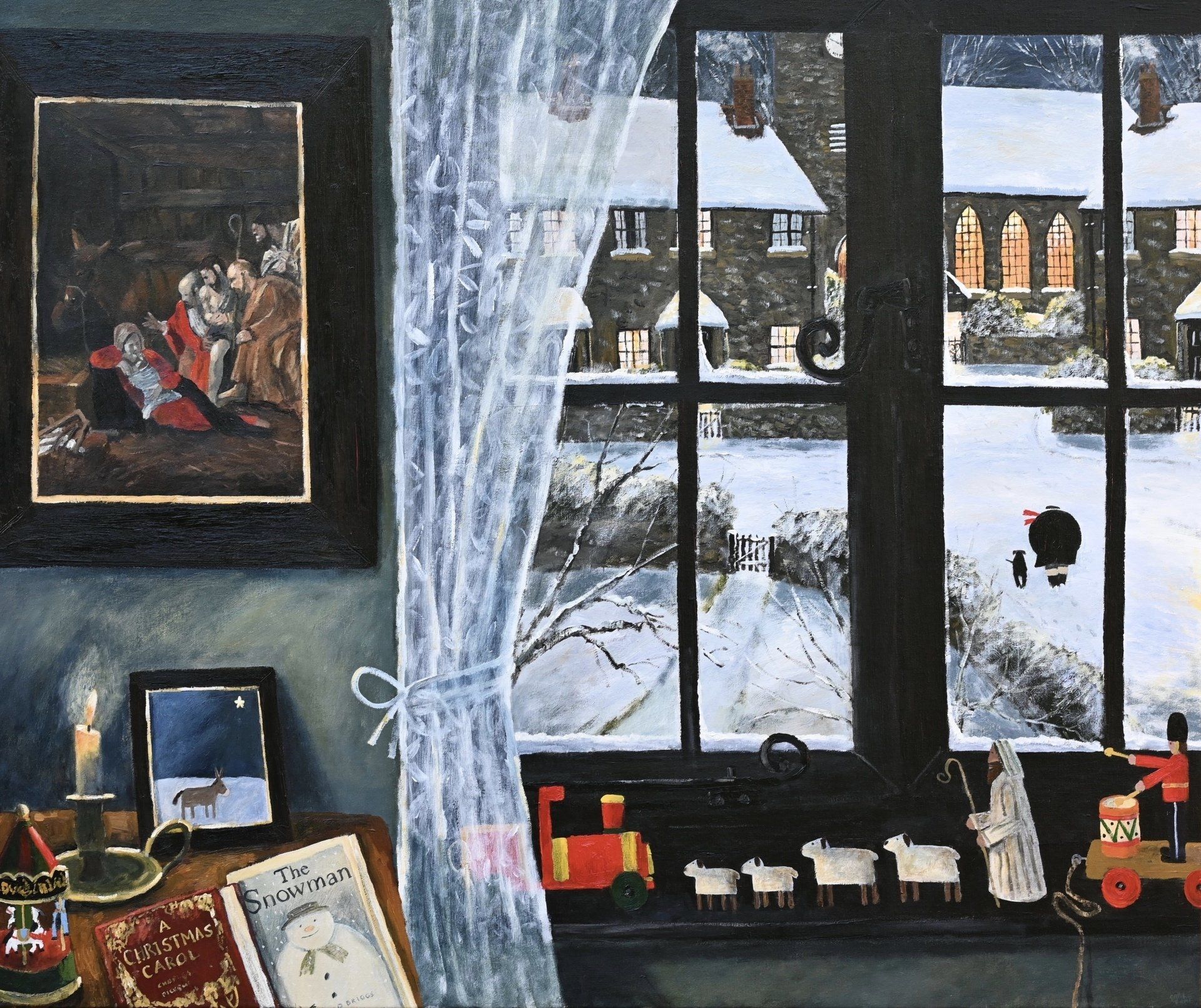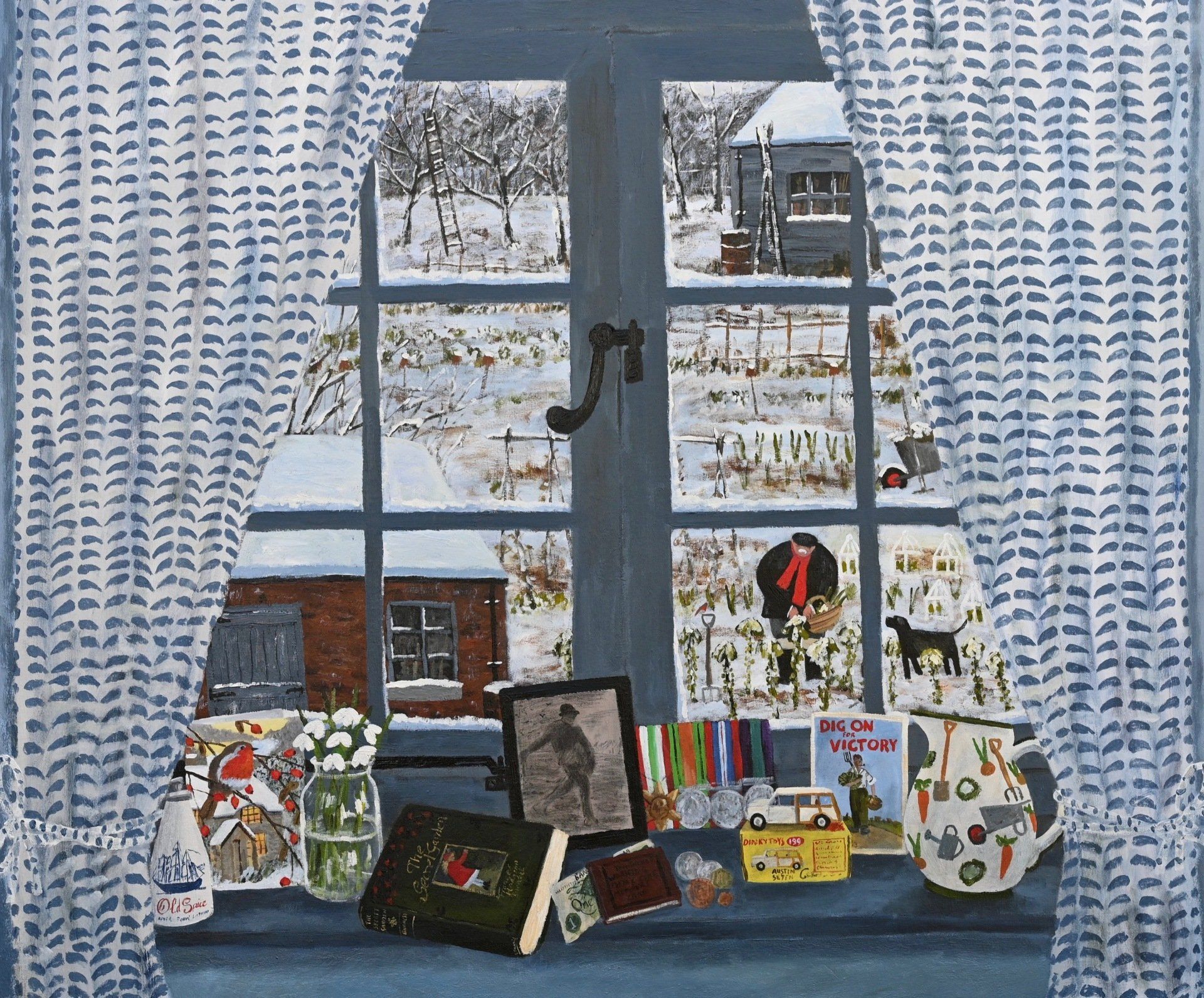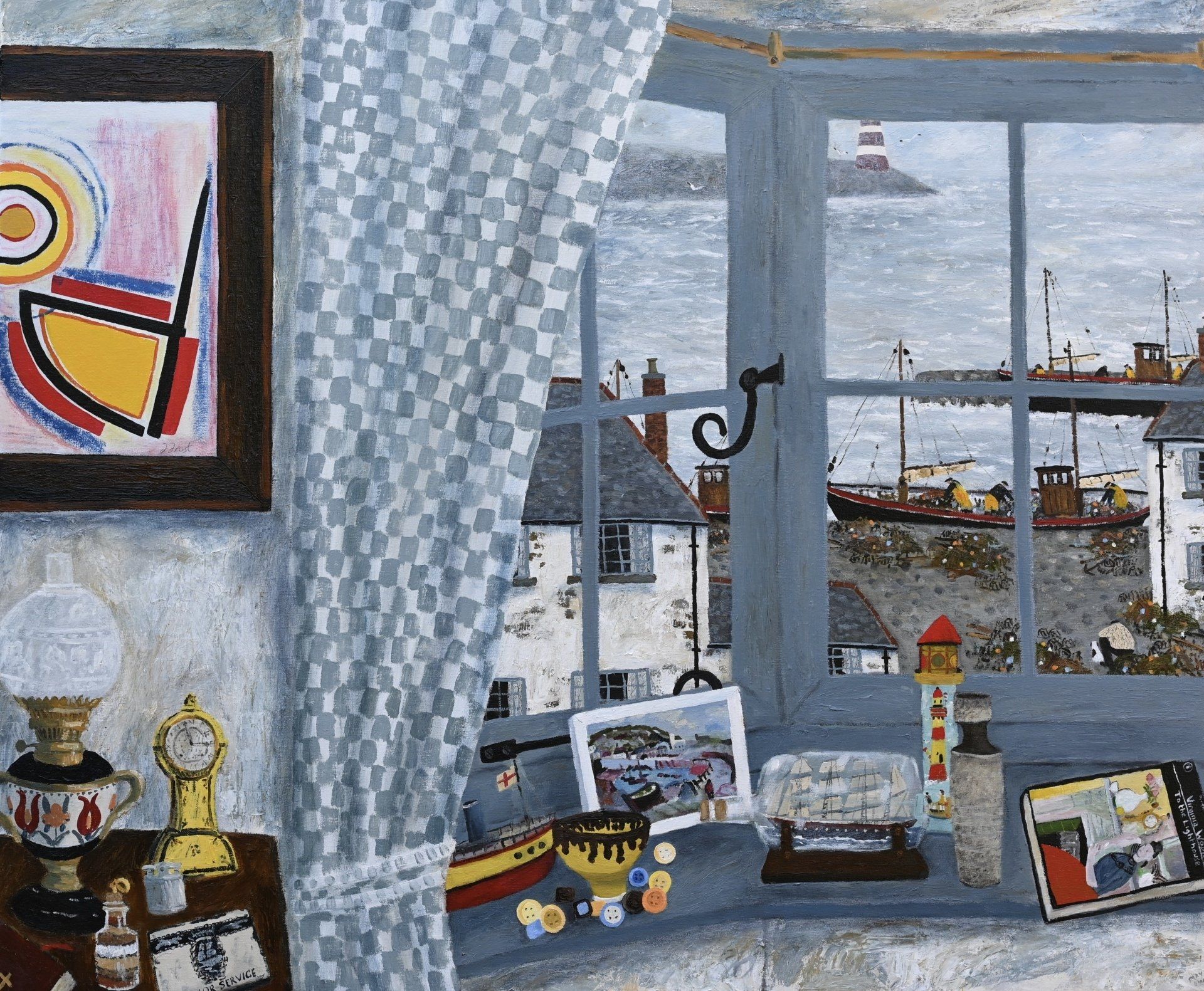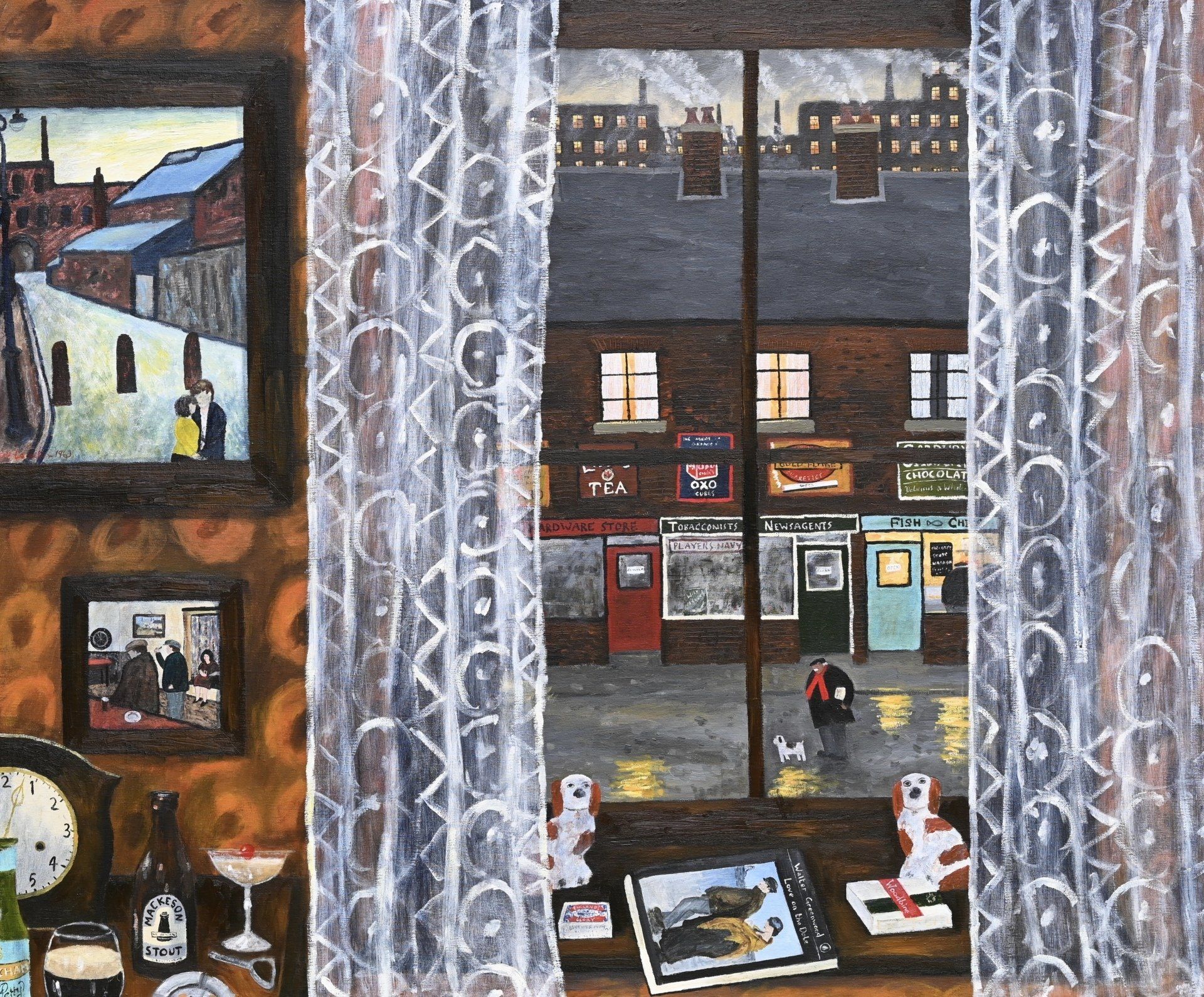Rooms With A View
All paintings are oil on canvas and measurements are in inches
A series of twelve impressive canvases, each measuring 40 by 48 inches – Bunt continues his exploration of the four corners of the British Isles.
We see Bert and his faithful dog explore the fields, farms and coastlines, drawing references to the many Modern British artists that continue to inspire him, as well as taking a closer look at the books, poems, mementos and family keepsakes that the artist draws upon in his distinctive artistic style.
Please email sophie@garybuntart.com to receive a hardback catalogue with an introduction by Frances Spalding and accompanying essays by Robin Cawdron-Stewart.
40 x 48 inches
● Sold
It was early in the morning, the old man was amongst the daffodils
Looking out across the lake, over the faraway hills
When the Word of God said “Be content like your dog, be as happy as Postman Pat
Write your letters today not tomorrow, for you can’t get yesterday back”
40 x 48 inches
● Sold
Sunflowers, bees
Rows of sweet peas
A robin, an old man and his dog
Cauliflowers, leeks,
7 days in a week
All of them made by God.
40 x 48 inches
● Sold
There's a man
Passes by my window
In a basket sits his dog
He rides along the lane
To a little flint church
He goes there to thank God.
He thanks him for
The little things
The beauty all around
He thanks him for the day ahead
Up here on the downs.
40 x 48 inches
● Sold
God created everything
He made the sky and sea
All of the pebbles on the beach
A kind Master just for me.
Now I'm a very happy dog
Not often do I complain
But whatever was he thinking about
When he filled the clouds with rain.
40 x 48 inches
● Sold
Little donkey
Winter's night
Guiding star
Shining bright
Drummer boy keeps
A steady beat
The shepherd
Watches over the sheep.
Through the snow
Go man and dog
They are off
To praise
The lamb of God.
40 x 48 inches
● Sold
So pleased he's changed the menu
We've had turkey everyday this week
Today we've got a corned beef pie
Sprouts, some greens and leeks.
After dinner he'll trim his tash
Have a soak in the old tin tub
A splash of old spice for the ladies
Down at the social club.
40 x 48 inches
● Sold
There's an old man
Who sits on the quayside
With his dog for company
He thinks about those days he spent
Fishing the stormy sea
Now he watches over the fishermen
For then he likes to pray
That God will keep them safe and sound
When they sail away.
40 x 48 inches
● Sold
This old man doesn’t worry
This wise man is in no hurry
On a hill he lays with his dog
Whatever comes tomorrow
Be it laughter or sorrow
It’s all in the hands of God.
His best friends by his side
He watches the tide
Not worried what life may bring
This old man knows
That if the wind blows
One day his ship will sail in.
He never complains
If he misses his train
And the next one is running late
He can’t turn time back
On a railway track
So he leaves all in the hands of fate.
This old man shows no greed
He planted some seeds
In an old terracotta pot
Gives thanks and prays
Never counting the days
He doesn’t mind if they grow or not.
Forget minutes, hours
Wake up, smell the flowers
Like the old man who leans on the gate
He wants you to know
Just be, let go
For good things come
To those that wait.
An overview of the twelve paintings below:
Amongst The Daffodils
Gary Bunt’s paintings bring with them a sense of warmth, familiarity and nostalgia - depicting a world now largely lost, and nowhere is this more pronounced than in his painting Amongst the Daffodils. He sets the scene in the ragged Cumbrian landscape of the Lake District with Bert and his faithful dog looking out over the expanse of water and rolling hills beyond. The field is studded with daffodils – a welcome reminder of that most glorious time of year when the promise of spring finally comes to fruition.
Inside it is as if we have stumbled into the nursery, being met with many of the friendly faces of our childhood, all with a link to the Lake District – a favourite region for the artist. Postman Pat, with Jess and their bright red van – the story’s creator John Arthur Cunliffe was a local to Kendal – and of course the many references to one of the most adored children’s authors Beatrix Potter. We see Peter Rabbit and Jemima Puddleduck rub shoulders with the beloved Beswick figures of Jeremy Fisher and Mrs Tiggywinkle. This is a painting that can’t help but bring a smile to your face, celebrating the very important role that the Lake District plays in many people’s childhood.
On the walls are works by Sheila Fell – the talented landscape artist that died tragically young – and Dora Carrington, with the view itself framed by curtains. When Wordsworth came to describe the Lake District he called it ‘the loveliest spot that man hath found’ – and Bunt does brilliant and beautiful justice to such a claim. Here we see the artist pen a heartfelt love letter to this very unique spot, and to childhood memories of the millions that have visited it.
When In Doubt
As a nation we are drawn to our gardens – and even those without seek solace in settling down on an evening to enjoy the odd episode of Gardener’s World. This national love affair was made even more pronounced following the pandemic, allowing many to step back and assess the importance of home comforts. For many the thought of stepping out into the garden brings a sense of pure, unbridled joy – from the flowerbeds to the vegetable patch – and Gary Bunt is no exception.
In this glorious painting we see Bert and his dog tending to the garden, lit up by the jewel-like flowers and a row of brilliant yellow sunflowers all standing to attention along the back brick wall. The window is ajar in the warm welcoming weather, and inside the interior is every bit as joy-filled, with Van Gogh’s painting a shrine to the most glorious of flowers! The artist was well-known for his love of yellow – famed for commenting ‘how glorious yellow is, it stands for the sun’ – and Bunt borrows further from the French master in the chair and pipe propped on the window sill beside a small nic nac bought by the artist’s daughter. Bees buzz on the decorated jugs, themselves stuffed with informal sprays of bright, brilliant flowers and a copy of Anna Lea Merill’s The Artists Garden sits in front of a drawing by Eric Ravillious.
Bunt’s garden holds a special significance for the artist, as it plays home to his ‘shed’ (or studio). Painting almost every day he makes his pilgrimage out through the garden of his Sussex home, soaking in the changing seasons in all their glory, and seeking inspiration for the paintings that lie ahead.
The Church Mouse
To many Gary Bunt is the most English of artists, and his highly original and distinct style celebrates the country’s vast and rich heritage. Nowhere more so than in his beautifully evocative painting The Church Mouse – a work that draws its title from John Betjeman’s 1954 poem telling the story of the humblest of church goers. Bunt sets the scene at harvest time in late summer, the distant field ablaze with sun-scorched yellow corn that is mirrored beautifully in his recreation of John Nash’s The Cornfield (1918) hanging to the left. Here is a golden, pleasant land, abounding with produce, as Betjeman’s furry central character recalls
‘For me the only feast at all
Is Autumn’s Harvest Festival.
When I can satisfy my want
With ears of corn around the font.’
But this is also a painting of memorial, remembering as we do every autumn those that gave their lives in conflict, the bright red poppy sitting in front an etching by Claire Leighton, and the words ‘we plough the fields and scatter’ singing forth from the open hymn book.
Through the window Bert sits in a moment of rest sipping his tea after bringing in the harvest hay, food that will keep the livestock going over the cold coming months. With the warm breeze sweeping in through the open window one can almost taste the sweetness of the dry and dusty air. On the window ledge sits a jug – one of Bunt’s own – depicting a woman feeding the chickens (the same chickens that now scratch around courtyard beyond). Perhaps a memorial to Bert’s wife, it forms a tender reminder of the importance of family and community at this time of year. It is a time to gather and reflect on the long and lazy summer past, and prepare for the winter months ahead.
The Downs
Gary Bunt’s love for Modern British art is broad and far-reaching – as seen in his recent series of artist-inspired interiors, shown together in 2021 – and in The Downs the artist sets the scene at Furlongs, the Sussex home of artist and designer Peggy Angus. Like nearby Charleston, Furlongs was a meeting point and melting pot for many artists of the first half of the twentieth century, including Edward Bawden and Eric Ravilious, whose influence and recreated works can be seen in this imagined interior.
The painting is awash with glorious golden light – the sort you get in late summer as the corn turns its crisp, burnt yellow. Through the window we see Mount Caburn in the distance – the ancient mountain that dominates the Sussex landscape. This is a painting of a truly English idyll the likes of which Ravilious and Bawden became celebrated for in the golden years of the 1930s before the outbreak of World War Two. And just as their work does, this painting acts as a memorial for the many aspects of the rural English countryside life that are now lost – the old hut taken from Ravilious’s The Church Army Caravan (1935) or the train borrowed from a painting by his wife Tirzah Garwood.
Angus’ design work is celebrated in the luscious wallpaper and the tiles that sit at either end of the ledge. Glorious summer flowers bring a sense of relaxed informality to the scene. In this painting Bunt whisks us away to a remote English village, the likes of which could have been plucked from Bawden and Noel Carrington’s 1949 publication (a copy of which balances in the foreground), and takes us back to that time of year when the pace slows, to those last glorious days of summer and the hazy years of a truly British hayday.
A Rainy Day
Britain’s position as an island has long been celebrated in its art forms – from the Elizabethan panoramas of epic sea-faring battles to the crudely painted scenes of the St Ives artist Alfred Wallis. Our relationship with the sea is often fraught, providing sustenance and pleasure, but also a serious risk of danger when the tide turns and the waves come crashing in. In A Rainy Day Gary Bunt sets the scene in the usually calm and placid Suffolk waters off Aldeburgh – a favourite seaside destination with a thriving cultural scene.
Through the rain spattered windows we see Bert walking along the pebbled beach, his bright red scarf dancing in the wind as beyond the waves spew white frothy foam. Whilst far from idyllic it is a day most British people will recognize up and down our expansive coastline. Inside offers warmth and sanctuary, crammed full of maritime references, from the brilliant Alan Lowndes painting (a work stolen from a gallery back in 2015 – now lost at sea like a wrecked ship) to the many lighthouses and lanterns offering safe passage to sailors. Pebbles borrowed from the beach fill the ledge (who can resist the urge to slip a smooth shiny pebble into a warm and welcoming pocket!) as they do the home of Jim and Helen Ede at Kettle’s Yard in Cambridge, and tobacco and Rizla papers snuggle for warmth alongside a copy of the Bible.
In A Rainy Day Bunt captures the character of a place so effortlessly. Here is a scene we can all relate to - a postcard reminder of the importance of our coastline and the communities that support it.
Far Far Away
In his paintings Gary Bunt has long celebrated all four corners of the British Isles – and the distinct identities of its make up. Here the painter sets his scene in the Scottish Highlands, and the canvas is awash with references that celebrate Scotland’s rich cultural heritage.
Through the window Bert leads a seemingly reluctant donkey to the stable, his dog cheekily catching a lift on its back, whilst chickens roam freely through the grass. Inside the cottage with white-washed walls, needlepoint samplers and tartan fabric stand proud alongside blue and white transfer ceramics and Wemyss pottery pieces. Here is a celebration of the strong crafts legacy of the country. Two of Scotland’s most famous cultural icons – Robert Burns and Edward Landseer – are paired together on the windowsill, with an elaborately decoration whisky decanter reminding us all of our favourite tipple.
In all of the paintings of this series Bunt depicts humble, lived-in interiors the likes of which he knew from childhood. Yes, they are filled with delicately painted reproductions of some of the greatest (and most valuable) artworks of the modern age, but equal attention and importance is given to the many trinkets, memories and cameos that ring true for so many of us. Their warmth and familiarity offers just one of the many reasons the artist has found such a welcome audience for his work, for these are paintings that we can all relate to – paintings that speak to us and remind us all of the important things in life.
Little Donkey
Religion plays a central role in much of Gary Bunt’s painting, and his faith is never far from the canvas. Yet in Little Donkey the artist looks beyond the purely religious aspects of the festive season to the family traditions that play such an important role for many of us. As Bert and his dog head towards the brightly lit church for the midnight carol service a candle is left burning inside, watched over by a solitary donkey. Above hangs a copy of The Adoration of the Shepherds by the Italian master Caravaggio, depicting the Virgin Mary together with Jesus in the stable, a scene known throughout the western world.
Here is a painting emphasizing the importance of Christmas, particularly in relation to children. For many it forms part of our earliest memories, of family and friends gathering together to celebrate the season. It is a time of stories – both old and new, and here the Dickens classic snuggled beside Raymond Brigg’s The Snowman, first published in 1978. On the ledge a shepherd leads his flock towards the star, followed closely by a little wooden drummer boy – their passage obscured by a toy train that belonged to the artist as a child.
In this painting Bunt reminds us of the many traditions we look forward to and celebrate at Christmas time – both religious and secular. A time of cold, crisp evenings with the crunch of freshly fallen snow and warm and cosy candle-lit interiors. But most important of all, he reminds us that it is a time to come together, to pause and to reflect.
Old Spice
Observing Gary Bunt’s paintings over the years we have come to know and love the central character of Bert and his dog, and in Old Spice were are offered a very personal insight into the importance of this central character. Initially drawn from the artist’s father, he has over the course of time come to embody the everyman, including of course the artist himself. In this tender and very personable painting Bunt looks back to ideas of family, including his own, and the memories and keepsakes we take with us when they have gone.
The very title of the work instantly recalls that familiar scent of fathers, grandfathers and uncles (Old Spice was Bunt’s uncle’s favourite) and through the frosty window we see the aging figure of Bert picking winter greens in his basket. Inside in the warmth the window ledge is cluttered with familiar keepsakes and mementos, from his father’s wartime medals through to the die cast model of a Morris Minor, the car that so often appears in Bunt’s paintings. Here references draw together the inside and outdoors, from a copy of Frances Hodgson Burnett’s The Secret Garden, through to the ceramic jug painted with the artist’s own designs of wheelbarrows, watering cans and spades.
In the Second World War Britain was told to ‘Dig On For Victory’ (as we see in a postcard reproduction propped on the ledge) and this sowed the seeds for an army of avid green fingered gardeners and allotment owners. This painting takes us back to these times of battling with the frozen earth and the great satisfaction of enjoying the homegrown vegetables as part of the weekly Sunday roast, with family gathered together around the dining room table, and perhaps that warm, familiar smell of an uncle’s favourite aftershave.
The Years
Many artists draw autobiographical references in their work, but in this present body of paintings Gary Bunt offers us a very personal and in-depth look into the many memories and objects that he has collected over the years - a never-ending pictoral scrapbook in the brain. These impressive paintings offer a glimpse of the subjects that inspire the artist to create, heading out every morning to his studio in the garden. In The Years – a title borrowed from Virginia Woolf’s novel that sits propped on the window ledge, childhood keepsakes in the form of buckets and spades stand proudly alongside work by the painter Ben Nicholson.
Bunt has always loved the sea, and the seaside more specifically. For many it brings back warming childhood memories of summer holidays and long lazy afternoons on the sand. This slow pace and passage of time is celebrated in the present work with the small pocket watch to the centre of the composition acting as a reminder. To the right we see a Christmas card by artist Bryan Pearce, and above a sampler quoting lines from the poem Sea Fever by John Masefield – a poem remembered fondly by the artist having won a prize for reciting it at Primary School. In the poem Masefield tells of the eternal allure of the sea -
‘I must go down to the sea again, to the lonely sea and sky;
And all I ask is a tall ship and a star to steer her by’
Here the painter celebrates the draw of the sea, and the passing of time, offering inspiration for many of his most celebrated and accomplished paintings to date.
Sail Away
Observation and quiet contemplation play a pivotal role in Gary Bunt’s paintings. It is the habit of most artists to watch and observe, but Bunt more so than many with his acute observational skills, married together with his rich understanding of a vast breadth of artistic and literary references. Nowhere is this more obvious than in the beautifully detailed painting Sail Away. In this work we see Bert, who is himself watching the fishermen unload their daily catch, hauling the nets onto the dockside just as they have done for generations.
Inside paintings by Terry Frost and Patrick Heron – two of the leading post-war St Ives artists – take pride of place alongside ceramics by potters Lucie Rie and Hans Coper, who together defined the course of studio ceramics in Britain. Nautical references too continue with the toy lighthouse and a copy of Virginia Woolf’s classic text referencing the red and white striped lighthouse just visible through the window. On the left sits an oil lamp – a prop borrowed from paintings made by painters Ben Nicholson and Christopher Wood when they painted together in Cornwall in the late 1920s – acting as a lasting reminder of the artist’s knowledge and interest in art history.
In this painting we see a thoroughly detailed, beautiful depiction that takes us to the very heart of the artist’s imagination. Yet this painting offers something more – Bunt gives us a lesson in how to experience and enjoy art, for these are works that the hidden inhabitant lives with and loves, just as we are encouraged to do with his own paintings.
Good Things Come To Those That Wait
In this painting – a work that addresses the importance of patience – we are met with not one but five depictions of the character of Bert and his faithful four-legged friend. Here is a painting that does not hurry, but rather celebrates the joys of taking one’s time, often in quiet contemplation, and as such is a painting that we all stand to learn from.
Through the window Bert awaits a train – always a risky game in Britain! – on an empty, rural platform. To the interior we see Bunt’s own works – a recumbent Bert lying in a lusciously empty field, savoring a moment of calm just as he does in the artists painted reproductions below. There is a Bert for all seasons. Here perhaps is a comment on our modern lives – so busy and fraught that often we forget the importance of taking a moment to sit back, breath and observe the ever-changing world around us. In the blue and white Minton tile the painter presents us with the fable of the hare and the tortoise, a tale that rewards those who take their time. And just as the small painting of Bert with his watering can on the ledge can reminds us, waiting your time for the seeds to grow allows you to appreciate even more the glorious flowers and the sweet scent of silence.
Friday Night
Whilst in much of his work Gary Bunt opts for a timeless approach that does not pin-point his central character to a specific period, in Friday Night the artist seeks inspiration from the 1960s. Setting the scene in the North of England, the dimly lit interior draws greatly from the work of celebrated northern artists such as Alan Lowndes, whose paintings hang on the orange-patterned walls. During his life Lowndes celebrated the social lives of the working classes in the late 1950s and ‘60s – often depicting bustling pub interiors or revelers making their way back home after a night on the town.
It is a decade that draws great affinity for the artist, and one that celebrated the importance of community and togetherness. On the sideboard are gathered a bottle of stout and a glass of Babycham (a true touchstone for the decade!) hinting towards a party that has continued late into the night. And through the window, flanked by kitsch Staffordshire flatbacks we see Bert and his dog beneath the advertising signs, having just left the fish and chip shop to begin their journey home.
On the ledge sits a copy of Walter Greenwood’s 1930 classic Love on the Dole – an indication of the hardships that each generation encounters – prevalent now as we face the difficulties of a post-pandemic economy – and a reminder that despite these hardships we come together stronger as a community to support each other.

